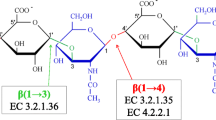Abstract
The present study attempts to establish the isoforms of hyaluronidase enzyme and their possible role in the spreading of toxins during envenomation. Screening of venoms of 15 snakes belonging to three different families revealed varied hyaluronidase activity in ELISA-like assay, but with relatively similar pH and temperature optima. The zymograms of individual venoms showed varied activity banding patterns and indicated the presence of at least two molecular forms of the enzyme. During envenomation, activity of hyaluronidase is considered crucial for the spreading of toxins and is presumed to distort the integrity of extracellular matrix through the degradation of hyaluronic acid in it. This property has been addressed through localization of hyaluronic acid in human skin and muscle tissue sections using the probe, biotinylated hyaluronic acid binding protein. Faint and discontinuous staining pattern of hyaluronidase treated tissue sections over intense staining of untreated tissue sections confirm the selective degradation of hyaluronic acid in extracellular matrix and thus provide an evidence for the spreading property of the enzyme.
Similar content being viewed by others
References
Chippaux JP, Williams, White J: Snake venom variability: Methods of study results and interpretations. Toxicon 29: 1279, 1991
Sasa M: Diet and snake venom variation: Can local selection alone explain intraspecific venom variation? Toxicon 37: 249, 1999
Manjunatha Kini R: Venom Phospholipase A2 Enzymes: Structure, Function and Mechanism. J Wiley, New York, 1997
Shashidhara Murthy R, Jagadeesha DK, Girish KS, Kemparaju K: Variation in biochemical and pharmacological properties of Indian cobra (Naja naja) venom due to geographical distribution. Mol Cell Biochem 229: 93, 2002
Xu X, Wang X, Xi X, Liu J, Huang J, Lu Z: Purification and partial characterization of hyaluronidase from five pace snake (Agkistrodon acutus) venom. Toxicon 20: 973, 1982
Baramova EN, Shannon JD, Bjarnason JB, Fox JW: Degradation of extracellular matrix proteins by hemorrhagic metalloproteinases. Arch Biochem Biophys 275: 63, 1989
Maruyama M, Suguki M, Yoshida E, Shimaya K, Mihara H: Broad substrate specificity of snake venom fibrinolytic enzymes: Possible role in haemorrhage. Toxicon 30: 1387, 1992
Anai K, Sugiki M, Yoshida E, Marayuma M: Neutralization of a snake venom hemorrhagic metalloproteinase prevents coagulopathy after subcutaneous injection of Bothrops Jararaca venom in rats. Toxicon 40: 63, 2002
Kreil G: Hyaluronidases - a group of neglected enzymes. Protein Sci 4: 1666, 1995
Tu AT, Hendon RR: Characterization of lizard venom hyaluronidase and evidence for its action as a spreading factor. Comp Biochem Physiol 76B: 337, 1983
Gregory FI, Tony C, Stern R: The hyaluronidases: A chemical, biological and clinical overview. Trends Glycosc Glycotechnol 8: 419, 1996
Pukrittayakamee S, Esnouf MP, McMichael AJ: Purification and inactivation of the factor x activator of Russel's viper venom with monoclonal antibodies. Mol Biol Med 1: 123, 1983
Kudo K, Tu AT: Characterization of hyaluronidase isolated from Agkistrodon contortrix contortrix (Southern copperhead) venom. Arch Biochem Biophys 386: 154, 2001
Stern M, Stern R: An ELISA-like assay for hyaluronidase and hyaluronidase inhibitors. Matrix 12: 397, 1992
Fiszer-szafarz B: Hyaluronidase polymorphism detected by PAGE: Application to hyaluronidases from bacteria, slime molds, bee and snake venoms, bovine testis, rat liver lysosomes and human serum. Anal Biochem 143: 76, 1984
Cevallos MA, Navarro-Duque C, Varela-Julia M, Alagon AC: Molecular mass determination and assay of venom hyaluronidases by SDSPAGE. Toxicon 30: 925, 1992
Lowry OH, Rosenbrough NJ, Farr AL, Randall RJ: Protein measurement with the folin-phenol reagent. J Biol Chem 193: 265, 1951
Tammi R, Ripellino JA, Margolis RU, Tammi M: Localization of epidermal hyaluronic acid using the hyaluronate binding region of cartilage proteoglycan as a specific probe. J Invest Dermatol 90: 412, 1988
Meyer LJM, Stern R: Age-dependent changes of hyaluronan in human skin. J Invest Dermatol 102: 385, 1994
Reissig JL, Stominger JL, Leloir LF: A modified colorimetric method for the estimation of N-acetylamino sugars. J Biol Chem 217: 959, 1955
Tengblad A: Affinity chromatography on immobilized hyaluronate and its application to the isolation of hyaluronate binding proteins from cartilage. Biochem Biophys Acta 578: 281, 1979
Thomas L, Etoh J, Stamenkovic S, Mihm MC, Byers HP: Migration of human melonoma cells on hyaluronate is related to CD44 expression. J Invest Dermatol 100: 115, 1993
Pukrittayakamee S, Warrell DA, Desakorn V, McMichael AJ, White NJ, Bunnag D: The hyaluronidase activities of some southeast Asian snake venoms. Toxicon 26: 629, 1988
Iwanaga S, Suzuki T: Enzymes in snake venom. In: C.Y. Lee (ed). Snake Venoms. Springer-Verlag, Berlin, 1979, p 61
Mebs D: Preliminary studies on small molecular toxic components of Elapid venoms. Toxicon 6: 247, 1969
Bode W, Gomis-Ruth FX, Stodkler W: Astacins, serralysins, snake venom and matrix metalloproteinases exhibit identical zinc-binding environments (HEXXHXXGXXH and Met-turn) and topologies and should be grouped into a common family, the 'Metzincins'. FEBS Lett 331: 134, 1993
Paine MJL, Moura-da-Silva AM, Theakston RDG, Crampton JM: Cloning of metalloproteinase genes in the carpet viper (Echis pyramidum leakeyi): Further members of the metalloprotease/ disintegrin gene family. Eur J Biochem 224: 483, 1994
Author information
Authors and Affiliations
Rights and permissions
About this article
Cite this article
Girish, K., Jagadeesha, D., Rajeev, K. et al. Snake venom hyaluronidase: An evidence for isoforms and extracellular matrix degradation. Mol Cell Biochem 240, 105–110 (2002). https://doi.org/10.1023/A:1020651607164
Issue Date:
DOI: https://doi.org/10.1023/A:1020651607164




